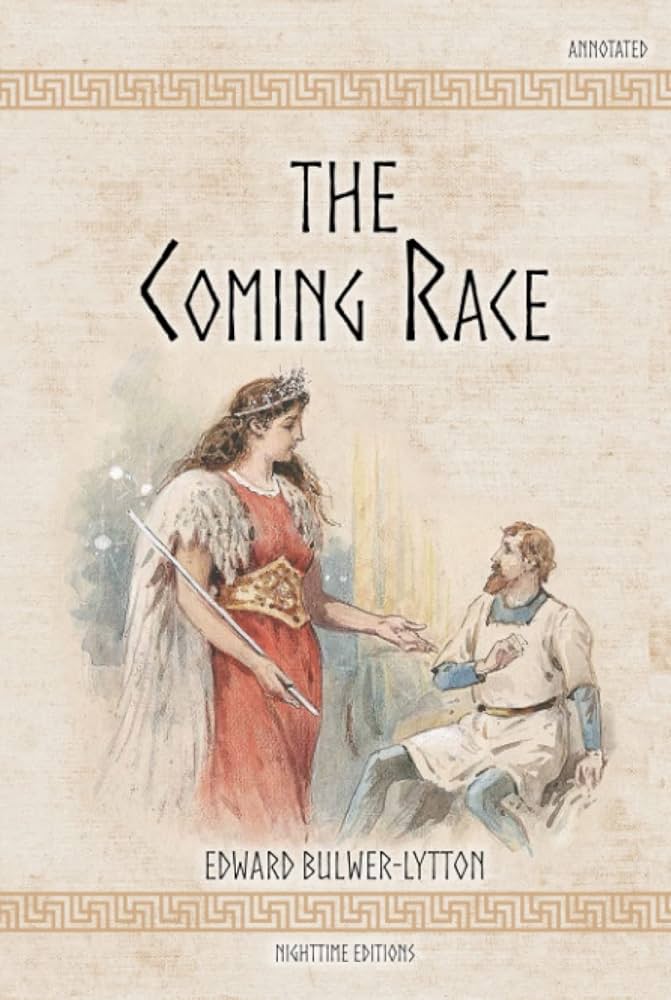Chapter XIX — The coming Race
byChapter XIX begins with a detour. As we returned toward the city, Taee suggested an alternate path that would take us past the central departure station used by travelers and emigrants. I agreed out of curiosity, eager to see more of this remarkable world. What awaited was a display of mobility unlike anything I’d encountered. The land transports, powered entirely by vril, ranged from small personal units to vast, multi-roomed homes on wheels. These vehicles moved silently, their motion graceful and fluid, almost as though they floated rather than rolled. Each served a specific purpose but shared the same silent energy source that defined so much of their civilization.
Nearby, I observed the launch of a convoy, its vehicles sleek and gleaming, destined not for tourists but trade. Goods, not passengers, were being carried to another Vril-ya settlement, showing the robust exchange systems in place between these far-flung communities. Their commerce, however, didn’t revolve around gold or other traditional forms of wealth. Instead, I was introduced to a currency made of an unusual fossilized shell—valued not for rarity but for history. It served small exchanges, while larger dealings relied on flat metallic plates or bills of exchange. These symbols of trade, though simple, were deeply respected. Transactions were not competitive but cooperative, reflecting a different worldview.
Taee explained that while the state collected taxes, the process caused no discontent. Contributions were calculated fairly and visibly returned to the people through improvements in infrastructure, science, and welfare. Everyone saw the benefit, which eliminated resentment. There were no loopholes, no evasion, and no fear of mismanagement. Public resources were seen as a shared responsibility, not as burdens. This tax-supported unity extended to vast systems of illumination, which bathed even the most remote regions in gentle light. Even the dimmest corners of their realm glowed with intention. Their sense of common good outshined the drive for personal accumulation. That, more than their machines, felt truly advanced.
Their aerial vehicles struck me most. They did not resemble our balloons or gliders but looked like long-winged ships, capable of directional flight with astonishing precision. Controlled by helms and rudders, these crafts used vril energy to ascend and navigate effortlessly. They moved without noise or vibration, stable even in mid-air. The scene of one lifting off, wings extended and glowing faintly, remained etched in my memory. I stood in awe, reminded of how limited our own world’s reach remained. What they had achieved was not the dream of one inventor, but a norm made possible by generations of refinement.
I was surprised to learn that emigration among the Vril-ya was not uncommon. Whole families sometimes moved from one region to another, either to seek new roles or to strengthen ties with distant tribes. Movement was voluntary, never forced, and always meticulously prepared. The station we passed functioned more like a calm marketplace than a bustling terminal. There were no farewells filled with sorrow, only matter-of-fact conversations and serene departures. The absence of emotional drama around leaving surprised me, yet it matched their broader cultural temperament—composed, orderly, and purposeful. Every journey, it seemed, served a collective goal.
While I marveled at their systems, I couldn’t help but reflect on the values beneath them. It was not just vril that powered their world—it was cooperation. Nothing was done for personal gain at another’s expense. The efficiency of their technology stemmed from the unity of their intentions. With no hunger for fame or profit, innovation bloomed without greed. What one discovered, all benefited from. The atmosphere of trust, more than any machine, created the real strength of their society.
The walk back to the city felt different after what I had seen. The landscape, gently lit and quietly humming with energy, appeared less alien than before. The silence was not emptiness—it was balance. Everything had a place and a function. And though I still felt like an outsider, I began to understand that their progress was not just mechanical—it was moral. They had built a civilization on the shared belief that the good of one must never outweigh the good of all. In that principle, perhaps, lay the greatest power of all.


